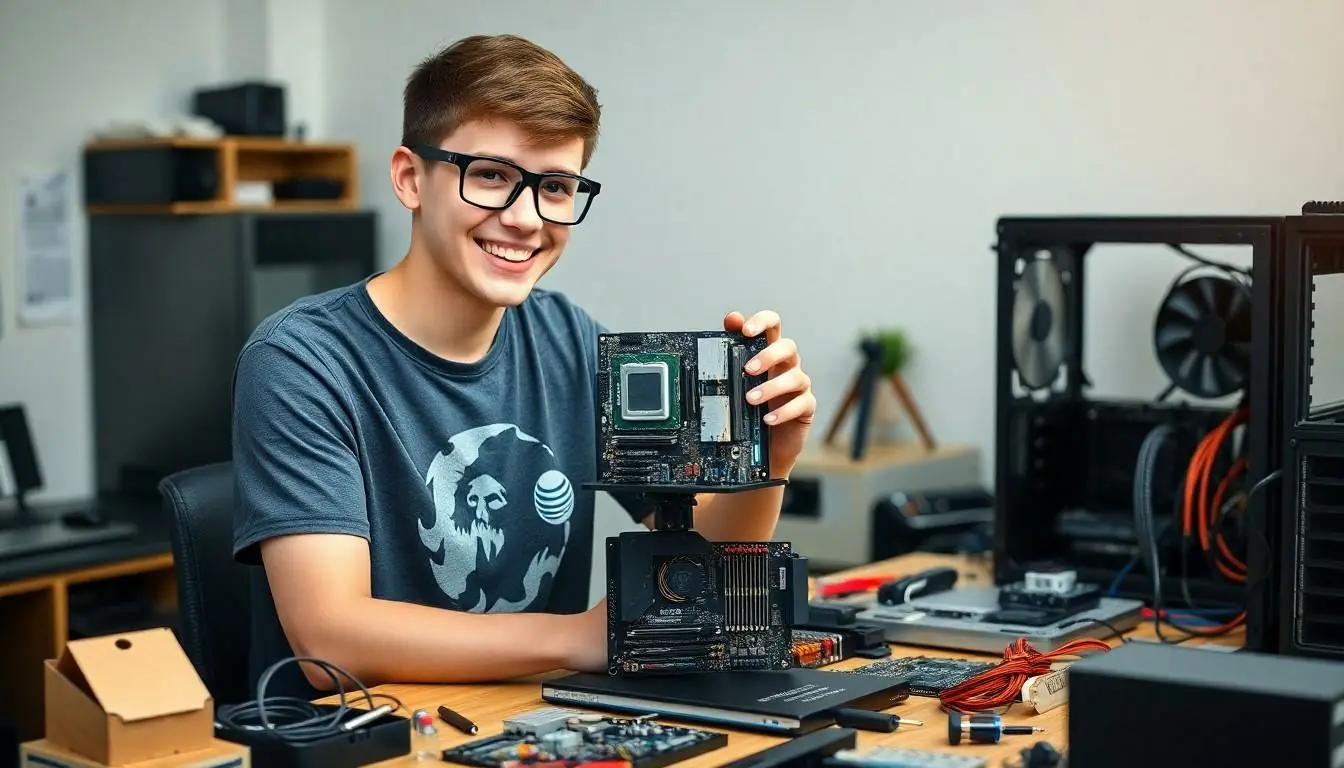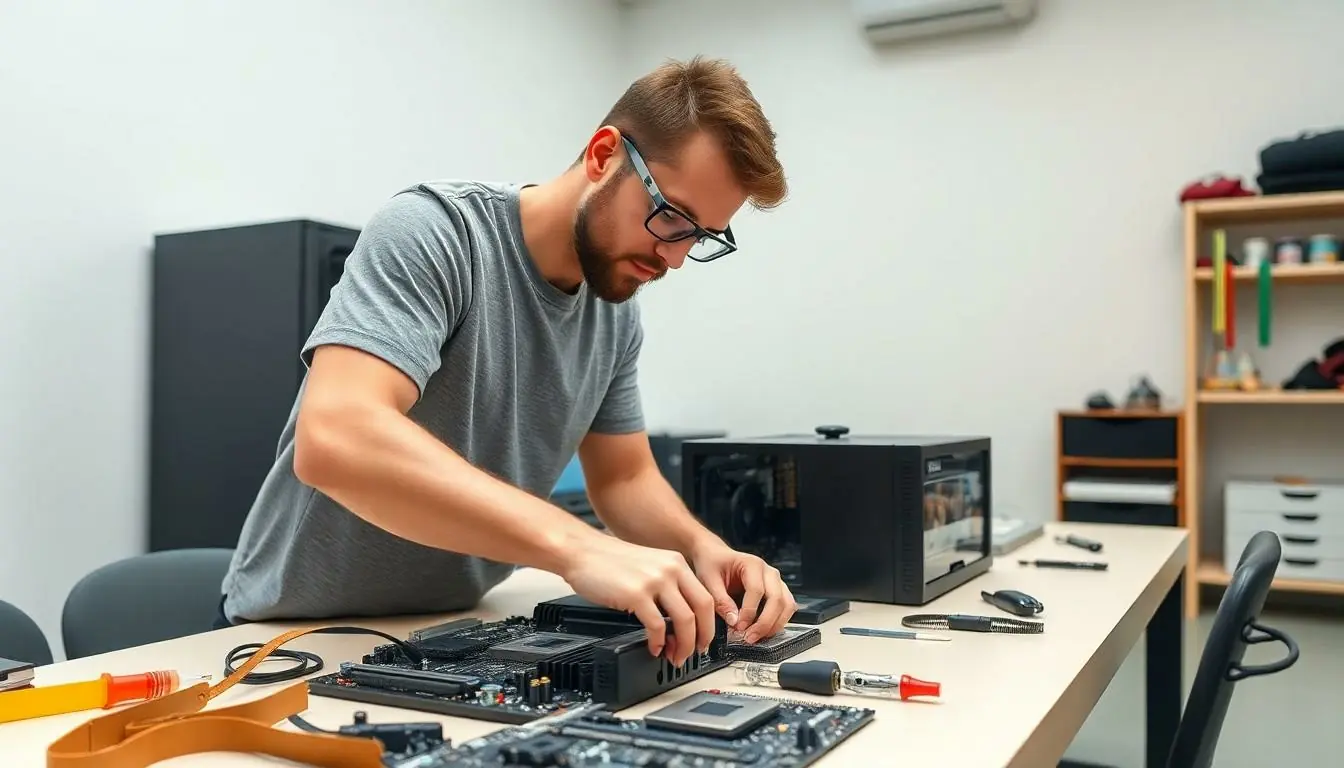Building a computer from scratch might sound like a task reserved for tech wizards and mad scientists, but it’s actually more accessible than it seems. With a little guidance and the right components, anyone can unleash their inner engineer and create a machine that’s tailor-made for their needs. Imagine the pride of saying, “I built that!” while your friends stare in disbelief, wondering if you’ve just been bitten by a radioactive motherboard.
In this guide, you’ll discover the essential steps to assemble your very own computer. From selecting the perfect parts to putting everything together without turning into a tangled mess of wires, it’s a journey filled with learning and a dash of humor. So grab your tools and get ready to dive into the world of DIY computing—where the only limit is your imagination (and maybe your budget).
Table of Contents
ToggleUnderstanding the Basics of Computer Building
Building a computer requires understanding essential components and tools. Familiarity with these elements simplifies the assembly process.
Components Needed for Building a Computer
Selecting appropriate components forms the foundation of a successful build. Key components include the central processing unit (CPU), which acts as the brain of the computer. The motherboard connects all parts and facilitates communication between them. Random access memory (RAM) impacts multitasking capabilities. Data storage options like solid-state drives (SSD) or hard disk drives (HDD) provide necessary capacity. The power supply unit (PSU) delivers energy to the system. Lastly, a graphics processing unit (GPU) enhances visual performance, especially for gaming or design work.
Tools Required for the Process
Gathering the right tools makes the assembly smooth and efficient. A screwdriver, preferably magnetic, assists in securing components tightly. An anti-static wrist strap prevents electrostatic discharge, protecting sensitive parts. Tweezers aid in handling small connectors and screws. Ensure to have zip ties on hand for cable management, enhancing airflow within the case. Additionally, a good workspace with adequate lighting fosters convenience during the build.
Step-by-Step Guide to Build a Computer from Scratch
Building a computer involves several important steps. Each step plays a critical role in crafting a functional machine.
Preparing Your Workspace
A clean and organized workspace ensures efficiency during assembly. Gather essential tools like magnetic screwdrivers, anti-static wrist straps, tweezers, and zip ties. Adequate lighting improves visibility when connecting small components. Clear the area of any clutter to maintain focus. Consider using a large, flat surface for ample space to lay out parts. Organizing components before starting helps prevent misplaced items.
Assembling the Components
Start by installing the CPU onto the motherboard. Align the CPU with the socket and gently secure it in place. Next, add RAM modules by inserting them into the appropriate slots; ensure they click into position. Mount the motherboard inside the case using standoffs. Proceed to connect the power supply cables to the motherboard and storage devices. Each connection must be firm to guarantee functionality. Finally, install the GPU, ensuring it clicks firmly into the PCIe slot, completing the assembly of the main components.
Installing the Operating System
Choose an operating system that meets your needs. Options include Windows, Linux, or macOS, depending on compatibility with hardware. Prepare a bootable USB drive for installation. Insert the USB into a designated port and power on the computer. Follow on-screen prompts to complete the installation process. Input necessary settings and software licenses as required. Finally, update drivers to optimize performance and security, ensuring everything runs smoothly.
Troubleshooting Common Issues
Building a computer can occasionally lead to frustrating issues. Identifying common problems can simplify the troubleshooting process.
Power Supply Problems
Power supply issues manifest as complete system failures or flickering power. Symptoms like these often indicate inadequate wattage for components. Selecting a power supply unit with a minimum of 80 PLUS certification ensures efficiency and reliability. Loose connections may also contribute to power disruptions. He or she should double-check all cable connections to the motherboard and peripherals. Replacing faulty power supplies can resolve persistent problems. Testing the power supply with a multimeter to measure voltage output offers a precise diagnosis.
Connectivity Issues
Connectivity problems hinder communication between components. Components might not boot or fail to communicate due to improper seating. Ensuring RAM and GPU are securely installed in their respective slots can eliminate these issues. Cable management often causes confusion; thus, organizing cables keeps everything tidy and makes troubleshooting easier. A malfunctioning motherboard may present additional challenges. He or she should consider replacing it if other solutions do not resolve the issue. Regularly checking BIOS settings for incorrect configurations can also provide a solution.
Tips for a Successful Build
Building a computer from scratch benefits from careful attention to detail. Effective strategies enhance both performance and organization during the process.
Optimizing for Performance
Choosing high-quality components significantly boosts system performance. Select a CPU with multiple cores and threads for efficient multitasking. Ensuring compatibility between the motherboard and CPU maximizes performance potential. Installing sufficient RAM enhances the ability to run multiple applications smoothly. Incorporate an SSD to reduce load times and increase overall system responsiveness. Optimizing cooling solutions keeps temperatures manageable, extending the lifespan of components. Finally, regularly updating software and drivers guarantees that the hardware operates at peak efficiency.
Cable Management Techniques
Effective cable management simplifies troubleshooting and improves airflow within the case. Using zip ties organizes cables neatly, reducing clutter around the interior. Strategically positioning cables behind the motherboard tray keeps them out of sight while maintaining accessibility. Utilizing cable sleeves adds a professional touch, enhancing aesthetics and reducing tangling. Labeling cables avoids confusion during future upgrades or troubleshooting sessions. Regularly checking cable connections ensures continued functionality and minimizes risks of short circuits. Prioritizing neatness contributes to a cleaner workspace and an efficient build process.
Conclusion
Building a computer from scratch is a rewarding experience that combines creativity and technical skill. By following the outlined steps and understanding the importance of each component, anyone can create a machine tailored to their needs.
With the right tools and a well-organized workspace, the assembly process becomes much smoother. Embracing potential challenges along the way only adds to the satisfaction of completing a custom build.
Ultimately, this journey not only enhances technical knowledge but also fosters a sense of accomplishment. With imagination and a willingness to learn, anyone can turn their vision into reality, paving the way for future upgrades and innovations.






